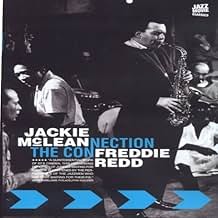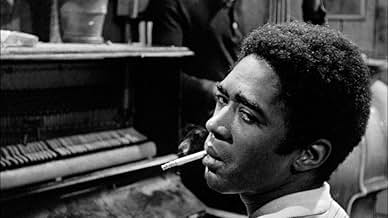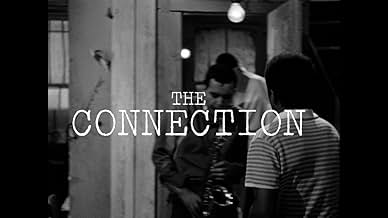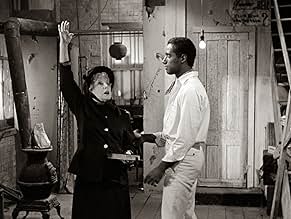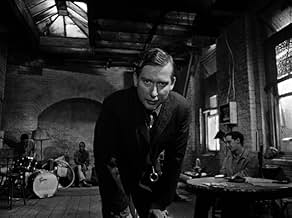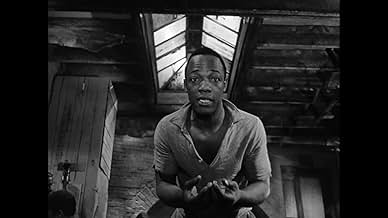IMDb RATING
7.0/10
1.1K
YOUR RATING
Men sent their own way await heroin in Leach's apartment.Men sent their own way await heroin in Leach's apartment.Men sent their own way await heroin in Leach's apartment.
Jerome Raphael
- Solly
- (as Jerome Raphel)
Jim Anderson
- Sam
- (as James Anderson)
Roscoe Lee Browne
- J.J. Burden
- (as Roscoe Browne)
Featured reviews
Regular readers of my comments know I study folding, and I suggest that it is a deep concern for many filmmakers going back many decades. Most of my viewing these days comes from reader suggestions.
This is one, and very interesting. Group it with "The Saragossa Manuscript" as an early experiment, probably influential. Crude and obvious, but of historical interest.
I will describe it because it is hard to find.
Ostensibly it is a documentary drama, filmed of then contemporary jazz musicians (man, dig?) in a seedy apartment. They are there for their pooled money to turn into a pooled high, then pooled music. The thing is framed by a device: the film is made by two people, the director and a photographer. During the film, the director has his first hit of heroin, and presumably succumbs to it thereafter. The movie starts with a statement by the photographer that the director has abandoned the project and he (the photographer) has assembled it for us.
In what we call the real world, this is a play about this film-making. So to begin, it is a film about a play (a very obvious play) about a film about a "real" drama. A theory of theater at the time was that such abstraction and acknowledgment of the medium would allow the form of the reality to shine through.
It is the theatrical equivalent of an architectural notion that you can see in the Paris Museum called Pompidou, where all the structure is more than exposed, exposed in a way so obvious it is supposed to be invisible.
You may buy this. I certainly did when I was an architect in this era until I actually designed a building using it.
The difficulties of making this work are enormous.
You can see those problems here. Cowboy is the agent who brings the high. He arrives in pristine white, an articulate black man who used to be a musician and now is a savior. He brings an old woman, a salvation army warrior from 70 years earlier, incidentally 70 years old and worried about her burial.
For this, you need extremely clean images, touchstone dialog (where you jump from pad to pad without muddying yourself), and actors who understand all the folds and can inhabit them all.
This has none of that. These are street performers after the manner of "The Living Theater" which eschewed just the kind of thinking this project demands.
What we end up with is a bunch of actors with empty lives without layers who give us a layered story about a bunch of musicians with empty lives because they left layers behind.
You'll probably want to watch "Hurly Burly" for something like this done well, or this for historical interest.
Ted's Evaluation -- 2 of 3: Has some interesting elements.
This is one, and very interesting. Group it with "The Saragossa Manuscript" as an early experiment, probably influential. Crude and obvious, but of historical interest.
I will describe it because it is hard to find.
Ostensibly it is a documentary drama, filmed of then contemporary jazz musicians (man, dig?) in a seedy apartment. They are there for their pooled money to turn into a pooled high, then pooled music. The thing is framed by a device: the film is made by two people, the director and a photographer. During the film, the director has his first hit of heroin, and presumably succumbs to it thereafter. The movie starts with a statement by the photographer that the director has abandoned the project and he (the photographer) has assembled it for us.
In what we call the real world, this is a play about this film-making. So to begin, it is a film about a play (a very obvious play) about a film about a "real" drama. A theory of theater at the time was that such abstraction and acknowledgment of the medium would allow the form of the reality to shine through.
It is the theatrical equivalent of an architectural notion that you can see in the Paris Museum called Pompidou, where all the structure is more than exposed, exposed in a way so obvious it is supposed to be invisible.
You may buy this. I certainly did when I was an architect in this era until I actually designed a building using it.
The difficulties of making this work are enormous.
You can see those problems here. Cowboy is the agent who brings the high. He arrives in pristine white, an articulate black man who used to be a musician and now is a savior. He brings an old woman, a salvation army warrior from 70 years earlier, incidentally 70 years old and worried about her burial.
For this, you need extremely clean images, touchstone dialog (where you jump from pad to pad without muddying yourself), and actors who understand all the folds and can inhabit them all.
This has none of that. These are street performers after the manner of "The Living Theater" which eschewed just the kind of thinking this project demands.
What we end up with is a bunch of actors with empty lives without layers who give us a layered story about a bunch of musicians with empty lives because they left layers behind.
You'll probably want to watch "Hurly Burly" for something like this done well, or this for historical interest.
Ted's Evaluation -- 2 of 3: Has some interesting elements.
This is a very difficult film, austere and hard, but after about ten minutes you can calibrate yourself to its rhythm, which is slow -- or, not so much slow as not fast, with extremely long takes in a one-room setting. The film, which is about a group of jazz musicians waiting for "the connection" (heroin) in an apartment, is essentially a filmed piece of experimental theater; it's very interesting, I think, and valuable for its honest portrayals of blacks (not all of the characters are black, but those who are are allowed to give equal amounts of monologues to the camera). The film itself, which is a product of the beat culture, is an experiment in subtle documentary satire -- the film is a film that's being made by a documentarian and his camera assistant; the documentarian becomes involved in the "film" himself by interacting with the musicians, trying to get them to act naturally for the camera by saying he's one of them, that he "reads" them. (The film is also a kind of Method film in the sense that the performances are strained and melodramatic -- the main character who owns the apartment has a boil that makes him scream at a few points -- and that everything is about the documentarian retaining emotional truth.) As the documentarian gets involved with the group (and after the connection arrives, with a female religious preacher in toe), the film feels almost like a public service announcement. It's a really fascinating document. 9/10
I first saw this movie in 1963 by hassling the cashier into selling me a ticket though I was under 18. I can't remember what I expected, but it was so interesting to me that I came back with a couple of underage friends--and got in again. This is a very sophisticated film not only for its time, but for now. There is no surprise ending or plot twist, but the use of the film-within-a-film allows the characters to relate to the outside world even though all the action takes place within one studio apartment. And what they have to say makes as much sense now as it did then. This is a film that could be re-shot with a minor change of clothing style and would look and sound cutting edge.
While "Traffic", in its glossy, artfully edited, mainstream way, explores the glossy, mainstream life of at least some drug traffickers, "The Connection", in its gritty, black-and-white, hand-held way, explores the gritty, hand-held life of at least some of the customers.
I would recommend this film for anyone who is interested in serious exploration of the drug culture. For people who think "Trainspotting" too mainstream--or at least too narrow in approach. "The Connection", too, is narrow, but it helps round out the picture begun by "Traffic" and"Trainspotting".
While "Traffic", in its glossy, artfully edited, mainstream way, explores the glossy, mainstream life of at least some drug traffickers, "The Connection", in its gritty, black-and-white, hand-held way, explores the gritty, hand-held life of at least some of the customers.
I would recommend this film for anyone who is interested in serious exploration of the drug culture. For people who think "Trainspotting" too mainstream--or at least too narrow in approach. "The Connection", too, is narrow, but it helps round out the picture begun by "Traffic" and"Trainspotting".
I'd like to clear up this jazz/heroin confusion (ignorance) that may stop you from watching this great film. Leach is the connection to Cowboy, and Cowboy is the connection to a dealer. The IMDb plot summary says that Cowboy is bringing "the connection" back to Leach's house, but he is really just bringing heroin. The fact that some of the people waiting for heroin are jazz musicians doesn't mean all jazz musicians were addicts, although most of the good ones were. With that said, I would advise any bee-bop fan to watch this film just for the amazing, and sole, footage of Blue Note heavies Jackie McLean and Freddie Redd. You will most likely also like the free-jazz directorial treatment of what was originally a stage play. The film also deserves credit for it's honest portrayal (in 1961!) of heroin addiction, neither glamorizing nor condemning it. The only problem I had was the slightly over-theatrical styles of some of the actors. Overacting did become the Leach character, however: "OHHH, MY BOIL!!!" If you liked "The Incident" or "The Pawnbroker," you'll like this one.
And what a stupid comment by a previous viewer. "Are all jazz musicians heroin attacks?" C'mon, there isn't a trend here, and perhaps you don't like jazz because you have no taste in music. Anyway, Shirley Clarke's cinema verite'style is put to the test , as we witness some sleazed-out New Yorkers in their subterranean dwelling, as they await their heroin "connection" -the mysterious Cowboy, played by Clarke's real-life lover, Carl Lee.
Did you know
- TriviaThis film was held up for release after the Board of Regents of the Motion Picture Division of New York State's Dept. of Education viewed the film and refused to grant it a license to be commercially shown. This was mostly due to the repeated use (seven times) of a four-letter word that rhymes with "hit" and is used as a slang synonym for heroin. The film was judged obscene but opened without a license anyway at the D.W. Griffith Theater on October 3, 1962, only to receive several bad reviews from the major N.Y. film critics. Director Shirley Clarke sued and a month later, the highest court in the state reversed the decision of the Board of Regents. However, the reputation of the film was already damaged and to this day, it has never recouped its original $167,000 budget.
Details
Box office
- Budget
- $167,000 (estimated)
- Runtime1 hour 50 minutes
- Color
- Aspect ratio
- 1.37 : 1
Contribute to this page
Suggest an edit or add missing content


